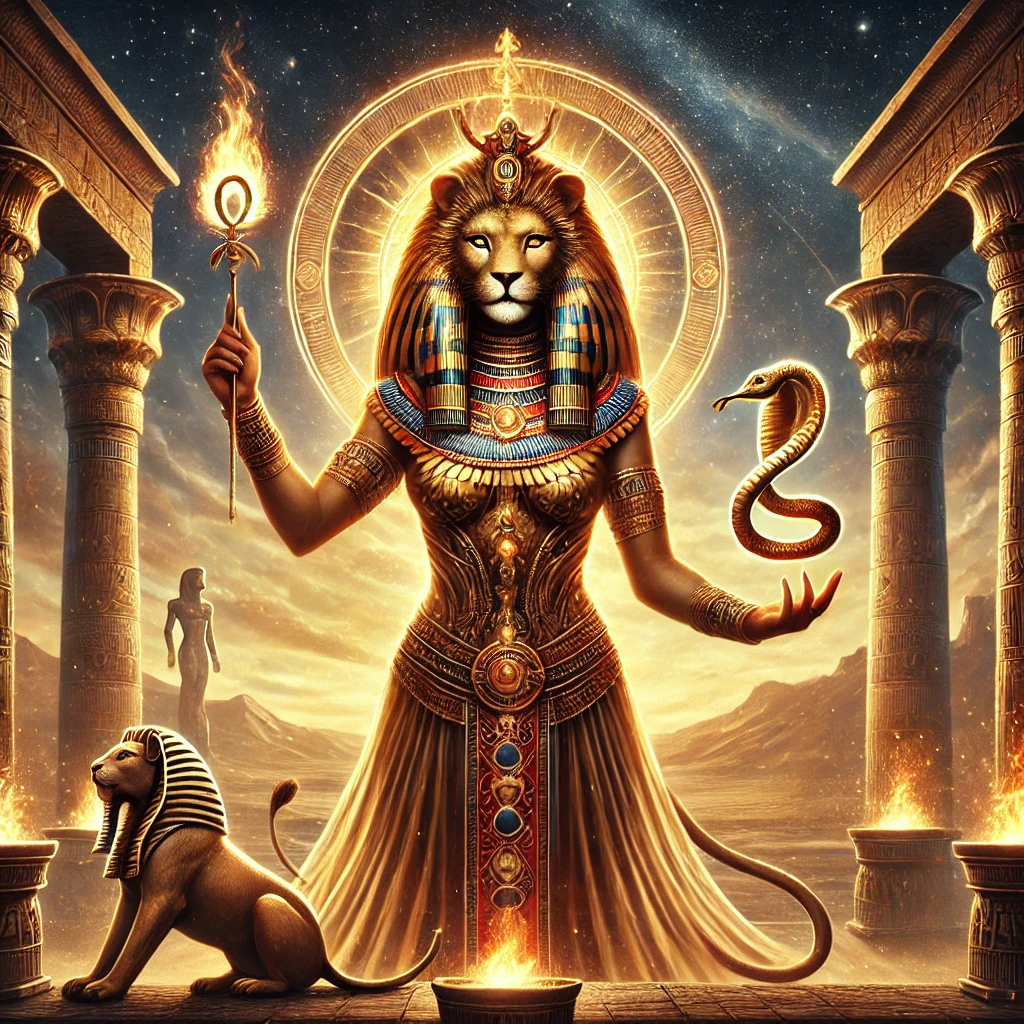Definition
Sekhmet is a powerful and complex deity in ancient Egyptian mythology, known as the goddess of war, destruction, and healing. With the fierce head of a lioness and the body of a woman, Sekhmet embodies both relentless wrath and miraculous restoration. She is a solar goddess associated with divine retribution, protection, and the transmutation of illness and imbalance into vitality and wholeness.
Origins and Mythological Role
Sekhmet’s name means “The Powerful One” in ancient Egyptian, and her presence was both feared and revered. She was closely associated with the sun god Ra, often described as his daughter or as the Eye of Ra, a fierce feminine force sent to punish wrongdoing and restore Ma’at (cosmic order).
The Myth of the Eye of Ra
In one of her most well-known myths, humanity defied the authority of the gods, and Ra, enraged, sent Sekhmet to punish them. She unleashed rampant destruction, nearly wiping out humanity. To stop her, Ra tricked her into drinking beer dyed red to resemble blood. Once intoxicated, her fury subsided, and she transformed into a gentler form—Hathor or Bastet, depending on the version of the myth. This story highlights Sekhmet’s duality as both destroyer and healer.
Symbols and Iconography
- Lioness Head – Symbol of strength, courage, and royal ferocity.
- Solar Disk and Uraeus (Serpent) – Signifying her solar aspect and divine protection.
- Ankh – Represents life, healing, and regeneration.
- Scepter or Was Staff – Symbol of power and dominion.
- Red or Gold Garments – Reflect her association with the sun and fire.
She is typically depicted:
- As a woman with the head of a lioness, often with a solar disk and serpent on her crown.
- Occasionally shown seated or standing, sometimes holding the ankh or scepter of power.
- In ritual statues and altars, she exudes an aura of both divine intensity and serene authority.
Roles and Powers
1. Goddess of War and Divine Wrath
Sekhmet was the protector of Ma’at, punishing injustice and disorder. She fought alongside pharaohs in battle and was invoked to defeat enemies and repel evil.
2. Goddess of Healing and Medicine
Despite her destructive power, Sekhmet was also considered a powerful healer. She governed diseases and plagues but also their cures. Ancient priests of Sekhmet were among the earliest known physicians, trained in both spiritual and physical healing practices.
3. Solar Goddess and Eye of Ra
As the Eye of Ra, Sekhmet embodies the sun’s scorching heat and divine authority. She acts as the sun god’s emissary, purifying the world through fire and bringing light to darkness.
4. Protector of the Pharaoh
Sekhmet was a fierce guardian of the pharaoh, ensuring the divine right to rule. Amulets and depictions of Sekhmet were often placed near thrones and tombs to invoke her protection and blessing.
Temples and Worship
Temple of Mut at Karnak
- Sekhmet was part of the Theban triad: Mut (mother), Amun (father), and Khonsu (son).
- A famous statue of Sekhmet in the temple was considered oracular and was consulted by priests for healing and divine messages.
Memphis – Cult Center
- At Memphis, she was honored as the consort of Ptah, the god of creation and craftsmen.
- Their child was Nefertum, the god of healing and perfume, creating a divine triad of creation, healing, and power.
Festivals and Rituals
- The Feast of Sekhmet was held annually to appease her wrath and ensure the Nile’s flooding brought fertility, not destruction.
- Priests performed daily offerings, incantations, and rituals to maintain her favor and invoke her protective healing energy.
Spiritual Significance and Modern Interpretation
Sekhmet is widely embraced in modern metaphysical and spiritual communities as a symbol of:
- Transformation through fire – Burning away illusions, disease, and stagnation.
- Sacred rage and righteous action – Channeling anger for justice, protection, and empowerment.
- Fierce feminine strength – Balancing strength with compassion, courage with care.
- Healing and protection – As a guardian of the body and spirit, Sekhmet supports physical and emotional healing.
- Empowerment and spiritual awakening – Helping individuals face their shadow and rise renewed.
Practitioners invoke Sekhmet in rituals of cleansing, empowerment, shadow work, energy healing, and setting strong boundaries.
Conclusion
Sekhmet is a goddess of extremes, embodying both fury and compassion, destruction and healing. As the lioness-headed protector of Egypt and the fierce Eye of Ra, she commands respect and awe. Yet as a healer and patron of medicine, she reminds us that true power lies not just in force, but in the ability to transform, restore, and renew. In modern times, Sekhmet continues to inspire those seeking inner strength, fierce love, and the courage to heal and protect what matters most.

